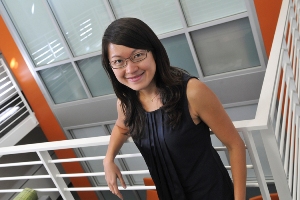Nov 4 2014
Stanford engineers have invented a device that can record when chemicals appear in water and in what concentration, without electronics, creating a simple and inexpensive sensor to find unknown sources of contaminations in streams.
 Mechanical engineer Sindy K.Y. Tang has invented a device that can capture a visible record of chemical reactions to record water contamination. Credit: Rod Searcey
Mechanical engineer Sindy K.Y. Tang has invented a device that can capture a visible record of chemical reactions to record water contamination. Credit: Rod Searcey
Sindy K.Y. Tang, an assistant professor of mechanical engineering, described what she calls her time capsule technology in a paper in the journal Lab on a Chip.
The time capsule captures a visible record of chemical reactions, like a barcode, that can be scanned to reveal when the reaction occurred and how much of a specific chemical was present. "We record the forensic history of chemical reactions," Tang said.
Because the time capsule has no mechanical or electrical parts, it uses no electricity and requires no batteries. That feature allows Tang to make devices that are smaller and cheaper than current sensors.
Now she plans to make her prototype smaller and extend the range of reactions it can record to open up new uses such as studying geothermal or petroleum reservoirs deep underground – places where pressure and temperature could destroy conventional electronic sensors.
How it works
The prototype time capsule is made of clear plastic and is about the size of a pinkie. Inside this device are two tiny tubes, each filled with a carefully chosen gel. Two tubes with different properties are needed to capture the information needed for discerning both the timing of reactions and the concentration of chemicals present.
One end of each tube is connected to a common reservoir, which contains a chemical that diffuses, or moves through the gel, at a predictable rate. This movement is the timer.
The other end of each tube is open to the environment, allowing chemicals dissolved in the water to seep into the capsule.
In their experiment the Stanford engineers dropped their time capsule into a solution that began as clean water but became contaminated with lead over time.
When the timer chemical met the lead inside the tube, these two substances reacted in a way that left a permanent, visible precipitation stain on the gel. Tang likened that stain to a barcode.
She envisions using this current version of the capsule to locate the unknown source of a chemical contamination in a stream.
In the field, engineers would throw the capsule into the water upstream of the contamination and let it flow downstream. At some point the capsule would interact with the contaminant and leave a time stamp on the capsule.
Based on the flow rate of the stream and the diffusion rate of the timing chemical, engineers would be able to estimate where along the streambed the capsule first encountered the contaminant. That would help them focus the search for the source.
Next steps
Having demonstrated this novel concept of recording the time and concentration of chemical reactions in water, Tang hopes to dramatically miniaturize the time capsule. Ultimately, she would like to make chemical sensors the size of the period in this sentence and use them to map chemical and physical environments deep underground.
"The capsules would have to be small enough to fit through the cracks in rock layers, and robust enough to survive the heat, pressure and harsh chemical environment below ground," Tang said.
In addition to making the time capsule technology smaller, the engineers also plan to experiment with different gels and timer chemicals, to increase the variety of reactions that they can record.
"Although the work is still at an early stage, we showed for the first time that it is possible to use chemical diffusion to record information about the time chemical reactions occurred, without the need for external power," Tang said.
Source: http://www.stanford.edu/